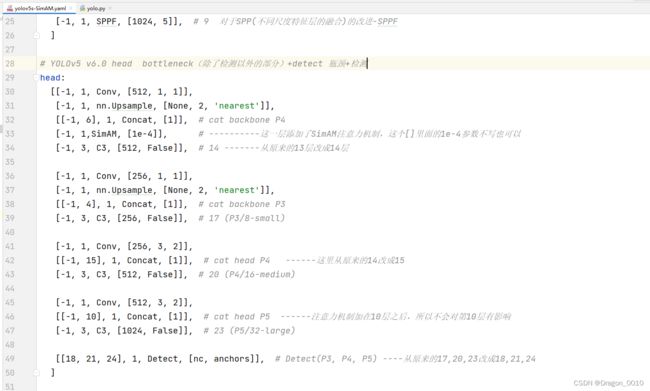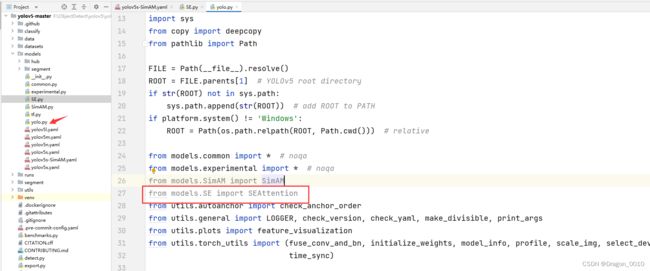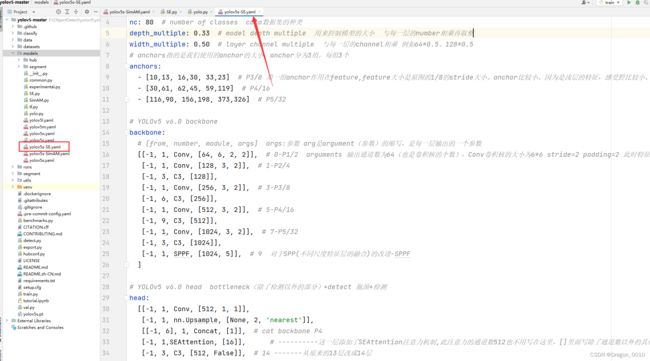零基础教程:Yolov5模型改进-添加13种注意力机制
1.准备工作
先给出13种注意力机制的下载地址:
https://github.com/z1069614715/objectdetection_script
2.加入注意力机制
1.以添加SimAM注意力机制为例(不需要接收通道数的注意力机制)
1.在models文件下新建py文件,取名叫SimAM.py
将以下代码复制到SimAM.py文件种
import torch
import torch.nn as nn
class SimAM(torch.nn.Module):
# 不需要接收通道数输入
def __init__(self, e_lambda=1e-4):
super(SimAM, self).__init__()
self.activaton = nn.Sigmoid()
self.e_lambda = e_lambda
def __repr__(self):
s = self.__class__.__name__ + '('
s += ('lambda=%f)' % self.e_lambda)
return s
@staticmethod
def get_module_name():
return "simam"
def forward(self, x):
b, c, h, w = x.size()
n = w * h - 1
x_minus_mu_square = (x - x.mean(dim=[2, 3], keepdim=True)).pow(2)
y = x_minus_mu_square / (4 * (x_minus_mu_square.sum(dim=[2, 3], keepdim=True) / n + self.e_lambda)) + 0.5
return x * self.activaton(y)2.在yolo.py头部导入SimAM这个类
3.然后复制yolov5s.yaml到同级目录,取名为yolov5s-SimAM.yaml
在某一层添加注意力机制
[from,number,module,args]
注意:!!!!!!!!!!!!!!!!!!!
添加完一层注意力机制之后,会对后面层数造成影响,记得在检测头那里要改层数
2.添加SE注意力机制(需要接收通道数的注意力机制)
1.新建SE.py
import numpy as np
import torch
from torch import nn
from torch.nn import init
class SEAttention(nn.Module):
def __init__(self, channel=512,reduction=16):
super().__init__()
self.avg_pool = nn.AdaptiveAvgPool2d(1)
self.fc = nn.Sequential(
nn.Linear(channel, channel // reduction, bias=False),
nn.ReLU(inplace=True),
nn.Linear(channel // reduction, channel, bias=False),
nn.Sigmoid()
)
def init_weights(self):
for m in self.modules():
if isinstance(m, nn.Conv2d):
init.kaiming_normal_(m.weight, mode='fan_out')
if m.bias is not None:
init.constant_(m.bias, 0)
elif isinstance(m, nn.BatchNorm2d):
init.constant_(m.weight, 1)
init.constant_(m.bias, 0)
elif isinstance(m, nn.Linear):
init.normal_(m.weight, std=0.001)
if m.bias is not None:
init.constant_(m.bias, 0)
def forward(self, x):
b, c, _, _ = x.size()
y = self.avg_pool(x).view(b, c)
y = self.fc(y).view(b, c, 1, 1)
return x * y.expand_as(x)
2.修改yolo.py
添加这两行代码
elif m is SEAttention:
args = [ch[f]]3.models下新建yolov5s-SE.yaml
# YOLOv5 by Ultralytics, AGPL-3.0 license
# Parameters
nc: 80 # number of classes coco数据集的种类
depth_multiple: 0.33 # model depth multiple 用来控制模型的大小 与每一层的number相乘再取整
width_multiple: 0.50 # layer channel multiple 与每一层的channel相乘 例如64*0.5、128*0.5
# anchors指的是我们使用的anchor的大小,anchor分为3组,每组3个
anchors:
- [10,13, 16,30, 33,23] # P3/8 第一组anchor作用在feature,feature大小是原图的1/8的stride大小。anchor比较小。因为是浅层的特征,感受野比较小。
- [30,61, 62,45, 59,119] # P4/16
- [116,90, 156,198, 373,326] # P5/32
# YOLOv5 v6.0 backbone
backbone:
# [from, number, module, args] args:参数 arg是argument(参数)的缩写,是每一层输出的一个参数
[[-1, 1, Conv, [64, 6, 2, 2]], # 0-P1/2 arguments 输出通道数为64(也是卷积核的个数),Conv卷积核的大小为6*6 stride=2 padding=2 此时特征图大小为原图的1/2
[-1, 1, Conv, [128, 3, 2]], # 1-P2/4
[-1, 3, C3, [128]],
[-1, 1, Conv, [256, 3, 2]], # 3-P3/8
[-1, 6, C3, [256]],
[-1, 1, Conv, [512, 3, 2]], # 5-P4/16
[-1, 9, C3, [512]],
[-1, 1, Conv, [1024, 3, 2]], # 7-P5/32
[-1, 3, C3, [1024]],
[-1, 1, SPPF, [1024, 5]], # 9 对于SPP(不同尺度特征层的融合)的改进-SPPF
]
# YOLOv5 v6.0 head bottleneck(除了检测以外的部分)+detect 瓶颈+检测
head:
[[-1, 1, Conv, [512, 1, 1]],
[-1, 1, nn.Upsample, [None, 2, 'nearest']],
[[-1, 6], 1, Concat, [1]], # cat backbone P4
[-1, 1,SEAttention, [16]], # ----------这一层添加了SEAttention注意力机制,此注意力的通道数512也不用写在这里,[]里面写除了通道数以外的其他参数:reduction=16
[-1, 3, C3, [512, False]], # 14 -------从原来的13层改成14层
[-1, 1, Conv, [256, 1, 1]],
[-1, 1, nn.Upsample, [None, 2, 'nearest']],
[[-1, 4], 1, Concat, [1]], # cat backbone P3
[-1, 3, C3, [256, False]], # 17 (P3/8-small)
[-1, 1, Conv, [256, 3, 2]],
[[-1, 15], 1, Concat, [1]], # cat head P4 ------这里从原来的14改成15
[-1, 3, C3, [512, False]], # 20 (P4/16-medium)
[-1, 1, Conv, [512, 3, 2]],
[[-1, 10], 1, Concat, [1]], # cat head P5 ------注意力机制加在10层之后,所以不会对第10层有影响
[-1, 3, C3, [1024, False]], # 23 (P5/32-large)
[[18, 21, 24], 1, Detect, [nc, anchors]], # Detect(P3, P4, P5) ----从原来的17,20,23改成18,21,24
]
注意:添加了SEAttention注意力机制,此注意力的通道数512也不用写在这里,[]里面写除了通道数以外的其他参数:reduction=16









